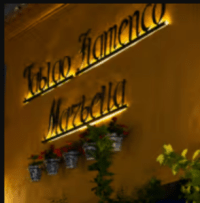Jose Fernandez Granados was born in 1915, in Utrera, a small flamenco enclave just a few miles outside of Seville.
Along with other heavyweight jondo singers like La Fernanda and Bernarda de Utrera, El Perrate brought the Utrera style of flamenco to the attention of the outside world.
His father, who also sang flamenco although not professionally, was a chair maker, a family trade that El Perrate was to learn in his youth.
Without scripts or structured compositions, the Flamenco artists let themselves be carried away by improvisation and the passion of flamenco. Witness dancing and singing, where the a cappella voice, the guitar chords and the rhythm of the dancers will fill the stage. Dining optional. Tickets for Flamenco Show at Tablao Flamenco in Marbella.
He was one of eleven children who were steeped in the Utrera flamenco tradition, although other than his sister Maria, El Perrate was the only one who continued this ancient old style of singing.
His powerful style of cante earned him recognition from a very early age and in 1926 he won first prize in a singing competition in Utrera where he won twenty-five pesetas for his efforts.
Perrate loved to sing in the bars and taverns of Utrera, and he was also a regular performer at the many gypsy get-togethers that were a regular occurrence in this pre-eminent flamenco town.
He married the daughter of Manuel Torre, Tomasa Soto, with whom he had eight children and this family is connected to one of the largest clans of flamenco artistes in Andalucía; the Peñas and Bácans, or El Clan de Pinini.
Members of the Pinini clan were to record together on numerous occasions and they became famous for their Fiestas en Utrera, where El Perrate, his sister La Parrata, and a collection of other family members would perform at traditional flamenco Christmas get-together.
Songs by the name of Villancicos, and Campanilleros, (thought to have been the invention of Manuel Torre) would be sung in a festive gypsy spirit. It was customary for the gypsies, especially in areas like Utrera, Lebrija, or the Barrio Santiago, to hold a fiesta during the week leading up to Christmas and the Perrate family would participate at many of these parties.
The whole family would join in, from the grandparents, right down to the smallest of children, to sing and dance these festive flamenco carols.
These parties were natural schools; the children would learn the different styles of flamenco simply by watching and being totally engulfed in this way of life.
It is a fact that the older generation of flamencos like El Perrate, were not interested in taking their flamenco outside of their hometown, they felt a strong commitment to their birthplace and the flamenco that it produced.
El Perrate remained for all of his life in Utrera, and with the exception of a brief period in Madrid, made his living at parties, taverns and the feria, never being tempted by the glitzy commercial world.
He also appeared at many of the local festivals like El Gazpacho in Morón de la Frontera, Caracoles in Lebrija, and of course El Potaje in Utrera, a festival that was to pay tribute to him and his sister in 1990.
Utrera was his inspiration and he excelled with the extremely gypsy interpretations of the soleá, buleria, tangos and the siguiriya, and El Perrate would sing them in a manner that could make a stone cry.
He had the spirit to move people with his emotive singing; like a fine old flamenco antique, no gloss, just pure gypsy tradition. He once said when referring to his nostalgic past- “We were the real thing, we hurt ourselves singing, nowadays they hold out their hands before opening their mouths.”
El Perrate died in 1992, after spending the last twenty years of his life in a wheel chair, but his style of song has been continued by two of his sons, Gaspar and Tomás de Perrate.
Recommended viewing.
Rito y Geografía del Cante. Vol 5 / 11
Book your stay in Andalucia Now!
